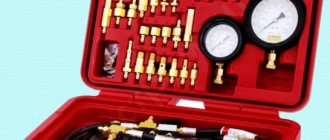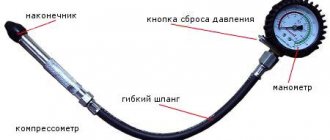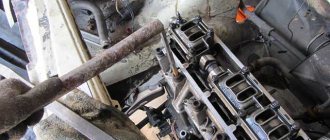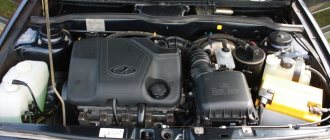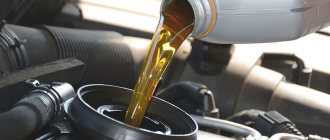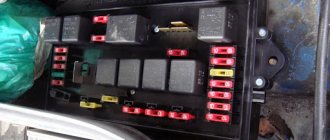Invalid compression values for the engine
At first glance, it may seem that the higher the compression parameters of the air-combustible mixture, the better. But actually it is not. Compression has an upper threshold that cannot be crossed, as this will lead to overheating of the engine, and, as a result, deposits of carbon deposits, excessive load on the pistons and rings, as a result of which engine parts may fail.
Low pressure in the engine leads to excessive consumption of fuel and oil. It is not permissible that in individual cylinders it differs sharply from neighboring ones. Different compression in the cylinders indicates serious problems in the engine - wear and defects that have appeared that require replacement or repair of parts.
Thus, bad compression is:
- increased,
- low,
- different.
All of these signs of poor compression are a sign that the heart of the car needs repair.
WHAT THE COMPRESSION SHOULD NOT BE IN AN ENGINE
At first glance, it may seem that the higher the compression parameters of the air-combustible mixture, the better. But actually it is not. Compression has an upper threshold that cannot be crossed, as this will lead to overheating of the engine, and, as a result, deposits of carbon deposits, excessive load on the pistons and rings, as a result of which engine parts may fail.
Low pressure in the engine leads to excessive consumption of fuel and oil. It is not permissible that in individual cylinders it differs sharply from neighboring ones. Different compression in the cylinders indicates serious problems in the engine - wear and defects that have appeared that require replacement or repair of parts.
What should be the compression in the engine?
How much compression should be in the engine for its long-term and trouble-free operation? Long-term practice of operating cars shows that ideally it should be 14 barrels in each cylinder. But a reduction to 11 barrels is allowed, provided that the difference in compression in the cylinders should be no more than 1 barrel. For example, a compression pattern of 11-12-11-12 is considered acceptable, but if the pressure in different cylinders is 11-12-11-9, or another combination of indicators that differs from normal, then the engine already needs repair.
What compression should be on a VAZ 2114 8 valve also depends on how long and under what conditions the car is operated. Ideal pressure, as a rule, occurs with a new engine, or one that has just come out of a major overhaul. During vehicle operation, compression may drop by 1-2 barrels. And this will also be within the normal range.
Compression in the cylinders of a VAZ 2114 engine 8 valves
The very concept of “compression” denotes the amount of pressure that the engine piston develops at maximum compression of the working mixture, that is, when it is at its lowest point. The higher this parameter, the higher the temperature the fuel-air mixture will burn, which means its consumption will decrease and the overall efficiency of the engine will increase.
How to check compression in a car engine with your own hands?
Compression measurement for VAZ 2114
The compression of the VAZ 2114, in fact, like the compression on any other car, depends on the following indicators:
- on the size of the clearance between the cylinder walls and the valves;
- on the volume of the incoming mixture, which, in turn, depends on the position of the throttle valve and the characteristics of the air filter;
- from the current engine temperature.
In turn, the size of the gaps between the cylinders and the elements of the piston group can also have a number of reasons:
- high degree of wear or burning of their walls;
- incorrectly set clearance between the cylinder walls and the valves;
- the entry of liquid gasoline into the cylinder (not in the form of a mixture), which causes the oil to be washed away from the walls and the clearance to increase.
Normal compression and its deviations
General cylinder diagram
According to generally accepted standards, the compression of the VAZ 2114 8 valves should ideally be 14 bars (almost 14 atmospheres). The maximum permissible deviation to the lower side is 3 bars (that is, the compression value should not be lower than 11 bar).
True, this is only allowed if the compression value in different cylinders differs by no more than 1 bar. That is, the following compression schemes are acceptable in four cylinders: 12-12-11-12, 12-11-12-11 and so on. If the pressure difference exceeds 1 bar, then such an engine must be urgently repaired.
For example: 11-14-12-8.
Also, it should be remembered that increased compression is no less evil than low compression or compression with a large variation in the cylinders. Thus, increased pressure in the cylinders of the VAZ 2114 can cause high load on engine components, deposit of carbon deposits on the cylinder walls, and ultimately lead to complete engine failure.
Thus, the normal compression should be in the range from 14 to 11 bar, and have a variation from cylinder to cylinder of no more than 1 bar.
In most cases, only new engines have an ideal compression of 14 atm. Even after short-term use, it can quickly drop by 1-2 units - this is considered quite normal. With further wear, it will begin to sag even more, and the wear itself will proceed differently in all cylinders, which will ultimately lead to a large variation in pressure in them.
What causes too high compression?
Let's look at the main reasons:
- Incorrect adjustment of the timing belt leads not only to increased compression, but also to decreased compression, depending on the direction of regulation.
- The appearance of scale on the valves, which appears due to the use of low-quality gasoline, oil or other automotive chemicals. Carbon deposits on the throttle assemblies and in the combustion chamber also appear due to engine overheating. Thus, overheating of the internal combustion engine is not only a consequence, but also a cause of high pressure of the air-combustible mixture. The operating temperature of the VAZ 2114 8 valve engine should not exceed 85-90°C.
- High compression can be caused by stuck oil seals. This reason is not difficult to detect. You just need to unscrew the spark plugs and inspect the cylinders. The appearance of an oil film on their walls will indicate an excess of oil in them, and the need to change the caps.
Compression is also affected by the level of oil pressure in the engine. If it is too high, then this leads to increased pressure of the air-combustible mixture.
Low pressure occurs if the rings are worn out or the valves are burnt out. The operating temperature of the engine also affects. If it is below normal, this will also affect the pressure of the air-combustible mixture.
The reasons for the lack of compression in the engine lie in improper operation and untimely preventive repairs. Sometimes air breaks through from several sides at once - for example, through valves, and at the same time through pistons with rings. Then the pressure disappears completely. It's simply not acceptable to let the car get into this state.
REASONS FOR INCREASED COMPRESSION IN THE ENGINE
Let's look at the main reasons:
- Incorrect adjustment of the timing belt leads not only to increased compression, but also to decreased compression, depending on the direction of regulation.
- The appearance of scale on the valves, which appears due to the use of low-quality gasoline, oil or other automotive chemicals. Carbon deposits on the throttle assemblies and in the combustion chamber also appear due to engine overheating. Thus, overheating of the internal combustion engine is not only a consequence, but also a cause of high pressure of the air-combustible mixture. The operating temperature of the VAZ 2114 8 valve engine should not exceed 85-90°C.
- High compression can be caused by stuck oil seals. This reason is not difficult to detect. You just need to unscrew the spark plugs and inspect the cylinders. The appearance of an oil film on their walls will indicate an excess of oil in them, and the need to change the caps.
Compression is also affected by the level of oil pressure in the engine. If it is too high, then this leads to increased pressure of the air-combustible mixture.
Low pressure occurs if the rings are worn out or the valves are burnt out. The operating temperature of the engine also affects. If it is below normal, this will also affect the pressure of the air-combustible mixture.
The reasons for the lack of compression in the engine lie in improper operation and untimely preventive repairs. Sometimes air breaks through from several sides at once - for example, through valves, and at the same time through pistons with rings. Then the pressure disappears completely. It's simply not acceptable to let the car get into this state.
How to measure compression correctly
Engine compression is measured with a fully charged battery. After charging and installing the power source in place, check the starter. It shouldn't create any problems either. Then warm up the engine. Its temperature during measurements should be 70-90°C.
It is necessary to unscrew all spark plugs from all holes. Also unscrew the fuel hose to stop the fuel supply. Prepare the compression gauge for use.
Compressometer
PREPARATION FOR MEASUREMENTS
Engine compression is measured with a fully charged battery. After charging and installing the power source in place, check the starter. It shouldn't create any problems either. Then warm up the engine. Its temperature during measurements should be 70-90 O C.
It is necessary to unscrew all spark plugs from all holes. Also unscrew the fuel hose to stop the fuel supply. Prepare the compression gauge for use.
Compressometer
How to measure compression with a compression meter
A device consisting of a pressure gauge and a rubberized tube that measures compression in the engine is called a compression gauge.
The following devices are used:
- clamping,
- universal,
- flexible,
- threaded
Experts believe that of all types of compression gauges, it is better to use threaded ones. They provide more accurate information. It is necessary to measure the compression in the engine in each cylinder separately. The measuring instrument hose is inserted into the spark plug socket.
Now that everything is ready for measurements, start the engine and squeeze the gas all the way, let the engine run for a while. Check the pressure gauge readings and record them. Move the compression tester hose to the next spark plug hole, and take measurements in the second and subsequent cylinders in the same way. Write down all the results and compare them.
What should the compression be in an injection engine?
Below you will learn how to correctly measure compression in a VAZ 2114 engine with injection type power.
If in at least one cylinder the pressure gauge shows a pressure below 10 barrels, then we need to look for the reason for such a low indicator. Otherwise, very soon it will fall in other cylinders.
Fill a medical syringe with about 10 milligrams of oil and spray it into the cylinder. Take the measurement again. If the pressure gauge readings increase, it means the piston rings are worn out and require replacement. If it remains at the same low level, then it is necessary to adjust the clamped valves or replace the burnt valves.
CORRECT COMPRESSION
How much compression should be in the engine for its long-term and trouble-free operation? Long-term practice of operating cars shows that ideally it should be 14 barrels in each cylinder. But a reduction to 11 barrels is allowed, provided that the difference in compression in the cylinders should be no more than 1 barrel. For example, a compression pattern of 11-12-11-12 is considered acceptable, but if the pressure in different cylinders is 11-12-11-9, or another combination of indicators that differs from normal, then the engine already needs repair.
What compression should be on a VAZ 2114 8 valve also depends on how long and under what conditions the car is operated. Ideal pressure, as a rule, occurs with a new engine, or one that has just come out of a major overhaul. During vehicle operation, compression may drop by 1-2 barrels. And this will also be within the normal range.
A new engine is the key to good pressure
How to measure compression without a compression gauge
Is it possible to measure compression without a device? Practice shows that yes, it is possible. But this method will give relative and approximate readings. To measure the compression indicator without instruments, remove the spark plugs from all cylinders except the one being tested. Manually rotate the crankshaft until the compression stroke ends (watch the marks - they should match). Perform this operation on all cylinders one by one. Where the pressure is low, it will take less effort to turn the crankshaft. In this way, of course, you will not get accurate compression readings in the engine. But it is possible to understand the presence of problems.
It is recommended to measure compression every 20-30 thousand kilometers, so every car enthusiast is recommended to have his own compression gauge. Its price is not so high that it is worth saving on it.
The approximate price of a device for measuring engine compression in online stores in the capital is from 600 rubles to 2 thousand. Branded models from Western manufacturers are more expensive – up to 8 thousand. In the regions, a device for measuring compression costs no more than in the capital. Its price varies depending on the manufacturer.
How to correctly measure compression in engine cylinders
Engine compression indicates the condition of the engine, its service life, power, and torque. This procedure must be performed every 20-30 thousand kilometers, as well as before purchasing a car. Even when checking at a service center, YOU will need knowledge of “how to correctly measure compression”, because... Servicemen love to deceive and make money from you. Let's start with the theory: Compression is the pressure created in the cylinder at the end of the compression stroke. Another term is appropriate here: Engine compression ratio. The engine compression ratio is expressed in the following ratio: compression/combustion chamber volume.
Measuring compression in the cylinders of a VAZ 2114 engine
The first stage involves intake or compression, during which the piston moves from top dead center (TDC) to bottom dead center (BDC), at which time the intake valve opens to supply the fuel-air mixture.
On the second, the piston rises from BDC to TDC, compression occurs, that is, the pressure rises sharply because all the valves are closed, the temperature rises and the mixture is ready to ignite. The higher the compression, the higher the power and efficiency of the engine.
The mixture ignites in the third stage, when the piston reaches TDC. Due to the released energy, the piston moves towards BDC.
In the fourth stage, when the piston is reversed, the exhaust valve opens and the burnt gases are pushed out of the working cylinder. When TDC is reached, all valves close and the piston is ready to repeat the entire four-stroke cycle.
What compression should be in the cylinders of a VAZ engine?
Normal engine compression is at least 10 bar (1.0 MPa), and the difference between the cylinders should not exceed 1 bar (0.1 MPa). If your compression is 11-12-11-12 from cylinders 1 to 4, then the engine is fine, but do not forget to adjust the valves every 2500 km. If you have 11-9-12-11, then you need to look for the reason and make repairs, because Driving in such conditions will only kill the engine.
How much should the ideal compression be? The ideal compression should be 14 bar for an 8-valve engine in each cylinder with minimal variation (14-14-14-14).
Compression in the cylinders of the VAZ 2110/2112 engine
Over time, car parts wear out, not only the chassis, but also the engine. Why is a cylinder compression test required? For example, you are buying a used car, and in order to find out what condition the engine is in, it is better to play it safe and check the compression so that you do not have to do a major overhaul after a couple of months. I bought my 10 when it was 5 years old; by that time the mileage was no longer low (about 90,000). When inspecting the car, I had a specialist with me who checked the compression in the cylinders.
If you notice that the engine does not pull, and at the same time the fuel and oil consumption has increased, then you should perform engine diagnostics. You can determine the causes of engine problems without disassembling them by measuring the compression in the engine cylinders. Engine compression is the pressure in the cylinders at the end of the compression stroke. It is measured in kg/cm2, bar, MPa or atmospheres. When the VAZ compression is high, then fewer gases will break into the engine crankcase and, therefore, more gases will do useful work, and this will have a positive impact on engine power. Thus, compression in the engine affects throttle response, engine stability, gas and oil consumption. Low engine compression will lead to a drop in engine power, a decrease in the vehicle's maximum speed, worse acceleration dynamics, and an increase in the amount of fuel and oil consumed.
Now let's take a look at how this is done. I’ll warn you right away that it’s better to check the pressure together, so ask someone to help you.
VAZ engine compression
The standard compression indicator of the VAZ 2110 can be calculated using the formula: Compression (kgf/cm2) = compression ratio * X coefficient
The compression ratio is in the technical characteristics of engines, and it is different for each engine model.
The X coefficient depends on the type of engine, and is equal to 1.2..1.3 for four-stroke engines with spark ignition; For example, compression of VAZ 2112 = 10.5 * 1.2 = 12.6. Now let's figure out how to measure engine compression: Progress of work
To carry out the work we will need: a compression meter a spark plug wrench 1. First of all, you need to warm up your car to operating temperature and turn off the ignition 2. Then you need to relieve the pressure in the fuel system. To do this, you need to remove the pump fuse and start the engine so that the remaining fuel in the system is used up. When the engine stalls, you can proceed to the next step 3. Disconnect the wire from the ignition module.
For 8 valve
for 16 valve
4. Remove the high-voltage wires from all spark plugs and turn out all 4 spark plugs with a spark plug wrench. 5. Next, install a compression gauge in the spark plug hole of one of the cylinders.
What is compression in an engine?
for 8 valve
for 16 valve
This is where you just need an assistant. He must sit in the car and, with the gas pedal fully depressed (full throttle opening), turn the starter (start the car) for 5-10 seconds. We record the readings of the device and check the pressure in the remaining cylinders in the same way.
The normal compression of a VAZ 2110 engine should be at least 1.0 MPa (10 bar) in each cylinder, the difference in values between the cylinders should not exceed 0.1 MPa (1.0 bar).
At the time of buying the car, my compression was 12 bar, which is a very good indicator, now, I really don’t know how much the compression will show, but there seem to be no problems with the engine)) I hope the article was useful to you, thank you!
2016-2020 24techno-guide.ru
All rights reserved. Use of site materials is possible only if you install an active direct link to our resource. FEEDBACK Home
What to do if there is a decrease or absence of compression in the engine cylinders?
(Main page of the site) Auto
(Reviews, feedback, test drives of cars)
Engines
(Description and design of various engines)
Techno
(Articles about equipment and mechanics)
Tuning
(Review of tuned cars)
Repair
(Do-it-yourself repairs)
Tractors
(Tractor special equipment)
Osago
(All about car insurance)
Car audio
(Music for the car)
Car LAWS
(Traffic rules, fines and car laws)
hacks
(Tricks of life)
Photo/Video
(No comments)
All articles
(All publications that are on the site)
How to measure engine compression?
To check the compression we need a spark plug wrench, a charged battery and a compression gauge. You also can’t do without an assistant.
- Warm up the engine to operating temperature.
- We turn out all the candles.
- We install a device for measuring compression (compressometer) into the spark plug hole that appears.
- The assistant presses the gas all the way and starts the car within 6-10 seconds.
- We remember the compression gauge readings and carry out similar operations on the remaining cylinders.
Low and different compression in the engine, what to do?
If, after checking the compression, the compression meter shows below 10 bar in at least one cylinder, then you urgently need to find out the cause and fix the problem, otherwise you risk losing compression in the remaining cylinders.
If, for example, you do not have sufficient compression in 1.4 and any other cylinder:
- We fill a medical syringe with about 10 cubic centimeters of motor oil.
- Spray oil into the hole that appears.
- We measure the compression again.
If, after re-measuring, the compression has increased, it means the rings are worn out. If the result remains the same, it means the valves are burnt out or jammed. Stiff valves can be adjusted, and burnt valves can be replaced.
High compression in the engine. Main reasons.
Don't be too happy if your compression readings are off the charts, this is in no way indicative of how cool your engine is. As stated above, the ideal compression for an 8-valve engine is 14-14-14-14. If your compression is higher than these numbers, then it’s time to think about malfunctions. High compression can damage the partitions of the pistons and tear the cylinders. Below are the main reasons for high/high compression: High compression is created due to excess oil in the cylinder, which is why it is sometimes also called “oil compression”.
- The valve stem seals (VSC) have worn out and died.
- The oil scraper rings are worn out or stuck. (In such cases, oil consumption is inevitable. Check the oil level: How to check the oil level in the engine? Also pay attention to starting the engine after a long stop, for example, in the morning. If the engine oil is consumed, the exhaust will be black).
- There may be carbon deposits in the cylinders. Try to get rid of it by decoking.
How to increase engine compression in other ways?
There are several options for raising compression without repair. These operations do not in any way guarantee an increase in compression, but you can try. But it is still recommended to eliminate the malfunction by mechanical action - eliminate the malfunction: replace the rings or replace the valves.
- Adjustment of valves. I tried it myself, it really works. The valve could be jammed and therefore not close, resulting in a compression leak.
- Roscoking – removes carbon deposits and excess oil in the cylinder. It only helps with stuck rings; if the valves are burnt out, there is no point in carrying out this operation.
